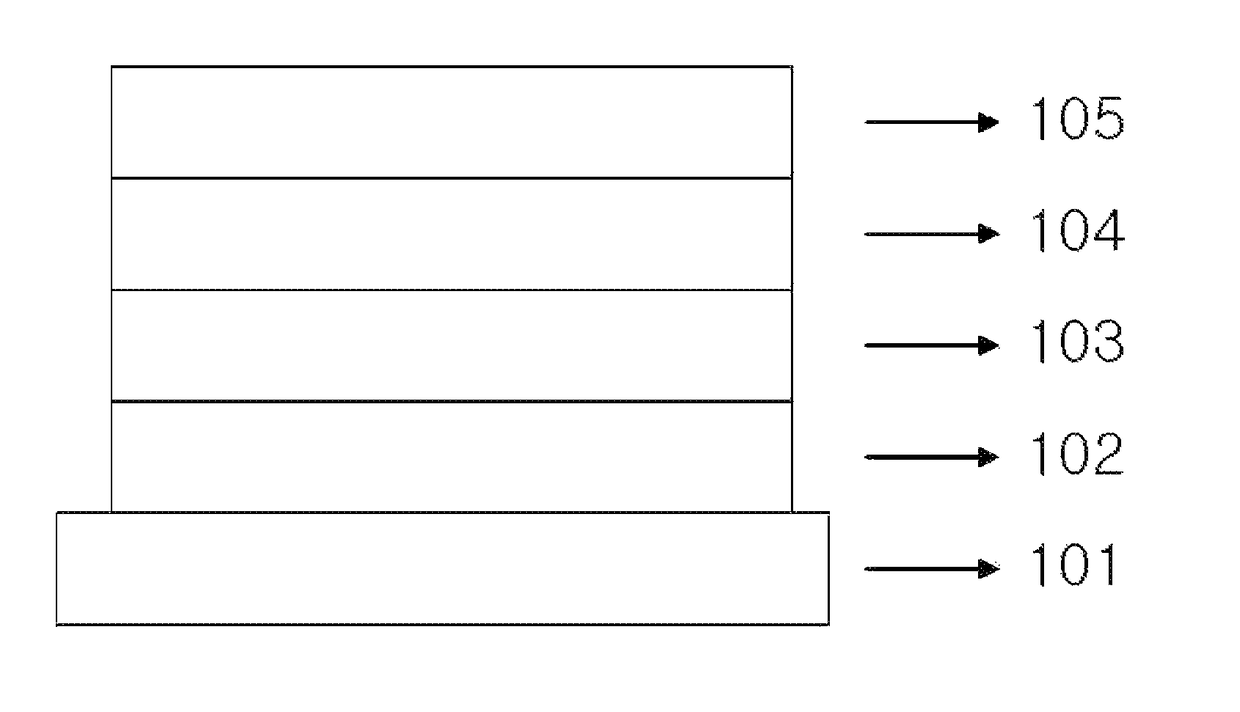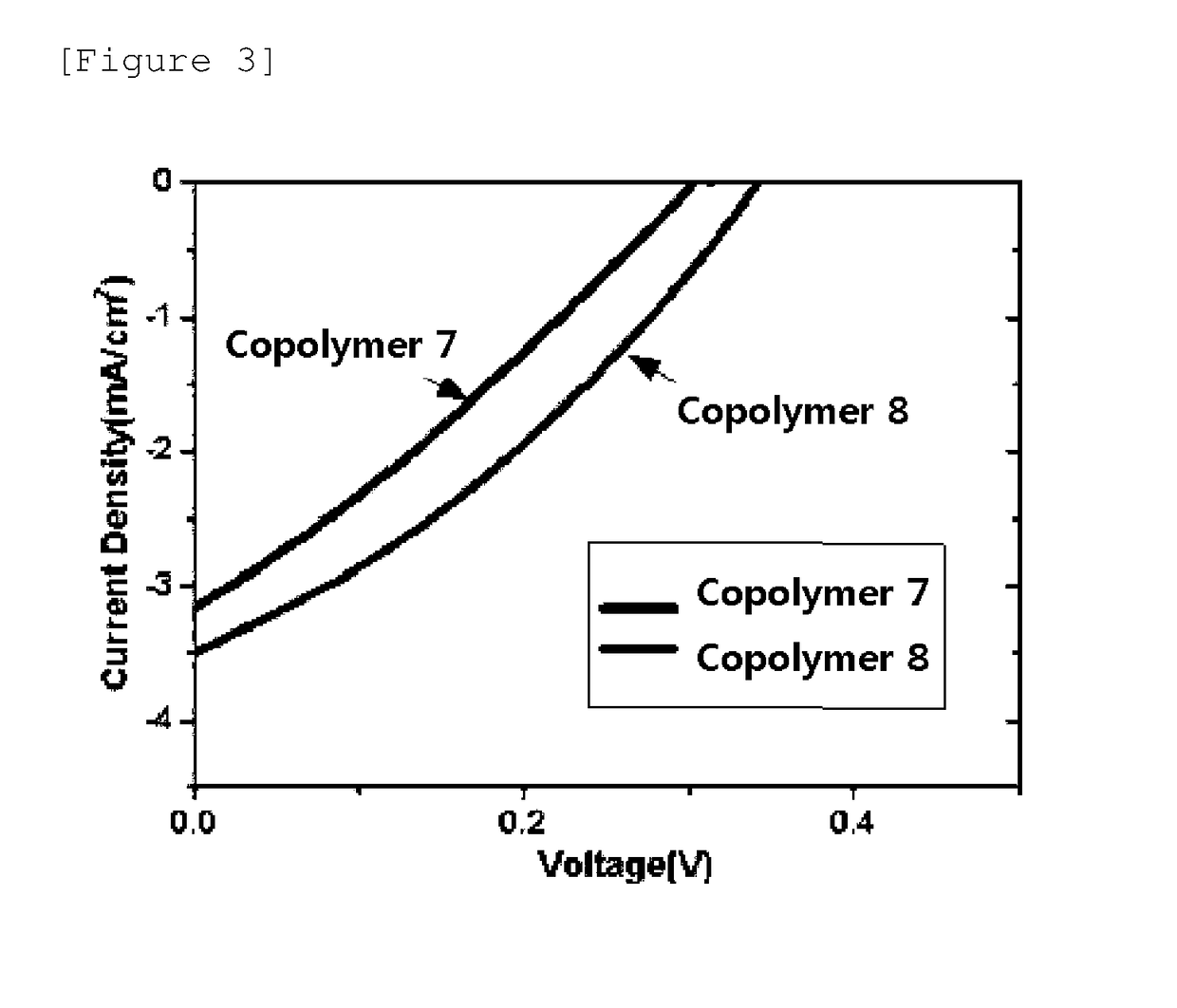Copolymer and organic solar cell comprising same
a solar cell and organic technology, applied in the field of organic solar cells and copolymers, can solve the problems of increased manufacturing costs, loss of electric charges, and annihilation of generated electrons and holes, and achieve the effects of increasing the open-circuit voltage and short-circuit current, increasing the efficiency, and increasing the planarity and solubility of the polymer
- Summary
- Abstract
- Description
- Claims
- Application Information
AI Technical Summary
Benefits of technology
Problems solved by technology
Method used
Image
Examples
example 1
Polymer Polymerization (Polymerization of Copolymer 1)
[0214]
[0215]In the present specification, 2,6-bis(trimethyltin)-4,8-bis(2-ethylhexyloxy)benzo[1,2-b:4,5-b′]dithiophene was prepared with reference to the prior literature (P. Morvillo, F. Parenti, R. Diana, C. Fontanesi, A. Mucci, F. Tassinari, L. Schenetti, Solar Energy Materials & Solar Cells 104, 2012, 45-52).
[0216]In the present specification, 4,7-bis(5-bromo-2-thienyl)-2,1,3-benzothiadiazole was prepared with reference to the prior literature (Q. Hou, Y. Xu, W. Yang, M. Yuan, J. Peng, Y. Cao, J. Mater. Chem. 12, 2002, 2887-2892).
[0217]In the present specification, 4,7-bis(5-bromothiophen-2-yl)-5,6-bis(dodecyloxy)benzo[c][1,2,5]thiadiazole was prepared with reference to the prior literature (C. H-Yang, Y. S-Chieh, C. C-Ti, C. C-Tsen, J. Mater. Chem. 22, 2012, 21549-21559). 5 ml of chlorobenzene, 0.4 g (0.5179 mmol) of 2,6-bis(trimethyltin)-4,8-bis(2-ethylhexyloxy)benzo[1,2-b:4,5-b′]dithiophene, 0.1187 g (0.2589 mmol) of 4,7-b...
example 2
Polymer Polymerization (Polymerization of Copolymer 2)
[0221]
[0222]In the present specification, 5,8-bis(5-bromothiophene-2-yl)-2,3-bis(3-(octyloxyphenyl)quinoxaline was prepared with reference to the prior literature (D. Gedefaw, Y. Zhou, S. Hellstrom, L. Lindgren, L. M. Andersson, F. Zhang, W. Mammo, O. Inganas, M. R. Andersson, J. Mater. Chem. 19, 2009, 5359-5363).
[0223]5 ml of chlorobenzene, 0.4 g (0.5179 mmol) of 2,6-bis(trimethyltin)-4,8-bis(2-ethylhexyloxy)benzo[1,2-b:4,5-b′]dithiophene, 0.1187 g (0.2589 mmol) of 4,7-bis(5-bromo-2-thienyl)-2,1,3-benzothiadiazole, 0.2229 g (0.2589 mmol) of 5,8-bis(5-bromothiophene-2-yl)-2,3-bis(3-(octyloxyphenyl)quinoxaline, 14 mg of Pd2 (dba)3 (tris(dibenzylideneacetone)dipalladium(0)), and 18 mg of tri-(o-tolyl)phosphine were put into a microwave reactor vial, and reacted under the condition of 170° C. for 1 hour. After the mixture was cooled to room temperature and poured into methanol, the solid was filtered and subjected to Soxhlet extract...
example 3
Polymer Polymerization (Polymerization of Copolymer 3)
[0226]
[0227]In the present specification, 5,8-bis(5-bromo-2-thienyl)quinoxaline was prepared with reference to the prior literature (N. Blouin, A. Michaud. D, Gendron, S. Wakim, E. Blair, R. Neagu-Plesu, M. Belletes, G. Durocher, Y. Tao, M. Leclerc, J. Am. Chem. Soc. 130, 2008, 732-742).
[0228]5 ml of chlorobenzene, 0.4 g (0.5179 mmol) of 2,6-bis(trimethyltin)-4,8-bis(2-ethylhexyloxy)benzo[1,2-b:4,5-b′]dithiophene, 0.1171 g (0.2589 mmol) of 5,8-bis(5-bromo-2-thienyl)quinoxaline, 0.2141 g (0.2589 mmol) of 4,7-bis(5-bromothiophen-2-yl)-5,6-bis(dodecyloxy)benzo[c][1,2,5]thiadiazole, 14 mg of Pd2 (dba)3 (tris(dibenzylideneacetone)dipalladium(0)), and 18 mg of tri-(o-tolyl)phosphine were put into a microwave reactor vial, and reacted under the condition of 170° C. for 1 hour. After the mixture was cooled to room temperature and poured into methanol, the solid was filtered and subjected to Soxhlet extraction in methanol, acetone, hexane...
PUM
| Property | Measurement | Unit |
|---|---|---|
| molecular weight distribution | aaaaa | aaaaa |
| carbon number | aaaaa | aaaaa |
| carbon number | aaaaa | aaaaa |
Abstract
Description
Claims
Application Information
 Login to View More
Login to View More - R&D
- Intellectual Property
- Life Sciences
- Materials
- Tech Scout
- Unparalleled Data Quality
- Higher Quality Content
- 60% Fewer Hallucinations
Browse by: Latest US Patents, China's latest patents, Technical Efficacy Thesaurus, Application Domain, Technology Topic, Popular Technical Reports.
© 2025 PatSnap. All rights reserved.Legal|Privacy policy|Modern Slavery Act Transparency Statement|Sitemap|About US| Contact US: help@patsnap.com



